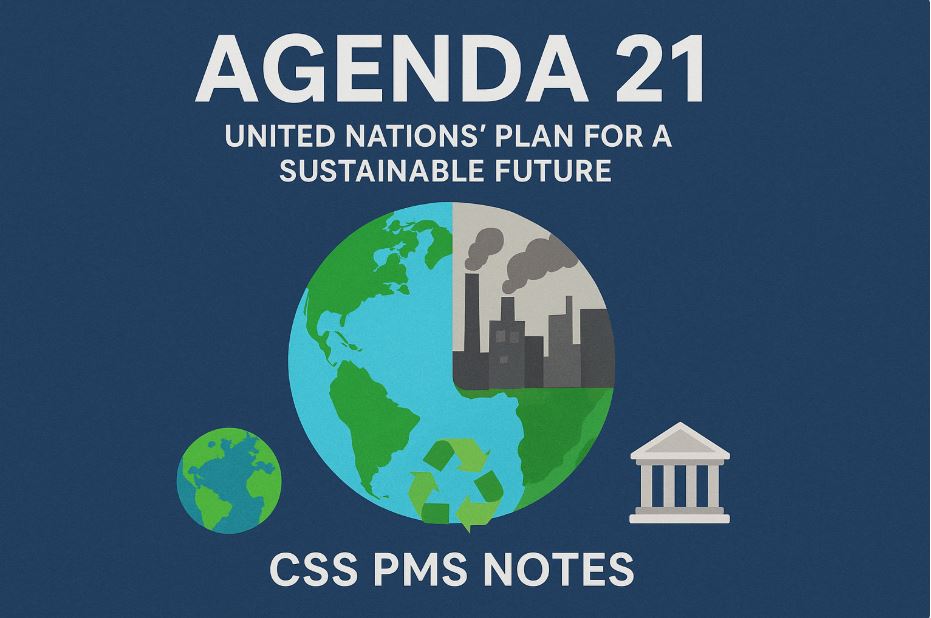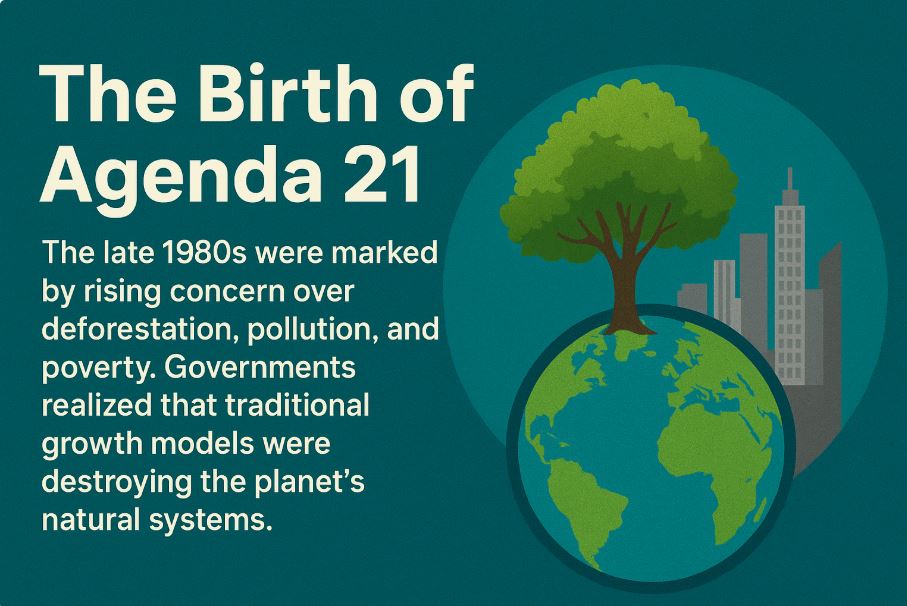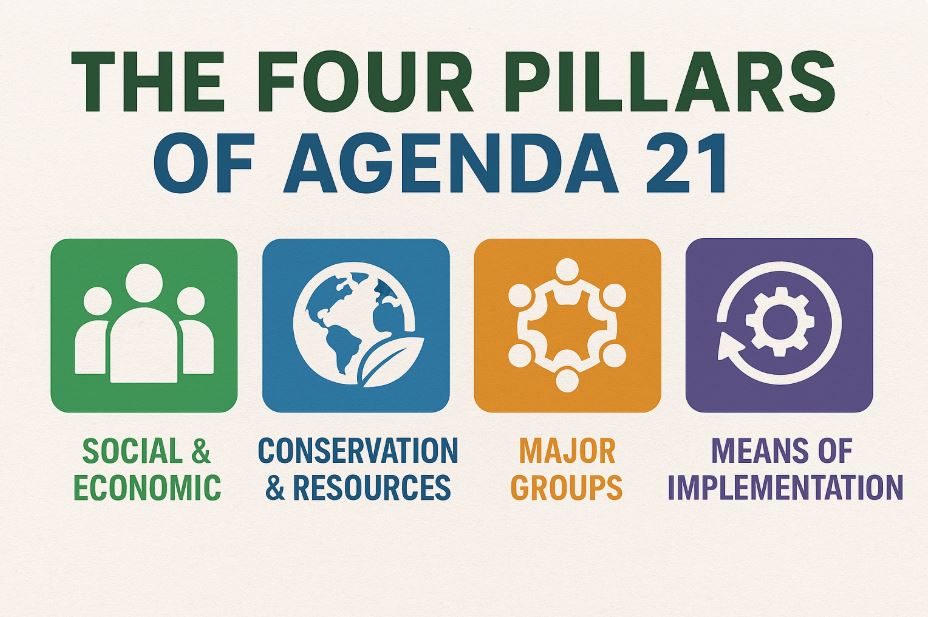Agenda 21: The Global Blueprint for Sustainable Development

Introduction: A Plan for the Planet
Back in 1992, when world leaders gathered in Rio de Janeiro for the United Nations Earth Summit, one goal united them — to protect our planet while allowing societies to grow.
The result was Agenda 21, a non-binding action plan that became the foundation of sustainable development across the world.
Although written decades ago, Agenda 21 still shapes today’s environmental policies, from climate action to local sustainability programs in cities across the United States.
The Birth of Agenda 21
The late 1980s were marked by rising concern over deforestation, pollution, and poverty. Governments realized that traditional growth models were destroying the planet’s natural systems.
This led to the United Nations Conference on Environment and Development (UNCED) — also called the Earth Summit — held in Rio de Janeiro, Brazil, in June 1992.
Representatives from 178 countries signed Agenda 21, committing to balance economic growth, social equity, and environmental protection.

What Is Agenda 21?
Agenda 21 literally means “Agenda for the 21st Century.”
It is a voluntary, non-binding framework designed to help governments, local authorities, and citizens work together for a sustainable future.
Rather than imposing global laws, Agenda 21 provides guidelines on how each country can adapt to sustainable practices through education, local planning, and environmental management.
Its core principle? 🌱 To ensure that economic progress does not come at the cost of the planet.
The Four Pillars of Agenda 21
Agenda 21 is divided into four major sections, each addressing a vital aspect of sustainability.

Social and Economic Dimensions
This section focuses on people. It calls for:
- Reducing poverty through inclusive economic policies.
- Improving health and education, especially for women and children.
- Promoting sustainable consumption and production patterns.
- Empowering women and strengthening the role of vulnerable groups.
It highlights how social justice and economic growth are interconnected with environmental care.
Conservation and Management of Resources
Nature stands at the heart of Agenda 21.
This section covers:
- Forests and biodiversity protection
- Water resource management
- Combating deforestation and desertification
- Climate change mitigation through renewable energy
- Pollution control and sustainable agriculture
It encourages nations to adopt environmentally sound technologies and maintain the balance between development and conservation.
Strengthening the Role of Major Groups
Agenda 21 recognizes that governments alone cannot achieve sustainability.
It highlights the roles of nine major groups:
- Women
- Children and youth
- Indigenous peoples
- NGOs
- Local authorities
- Workers and trade unions
- Business and industry
- Farmers
- The scientific and technological community
This inclusive approach ensures that every voice contributes to global sustainability.
Means of Implementation
This final section provides the how-to:
- Funding mechanisms for sustainable projects
- Technology transfer from developed to developing nations
- Science and capacity-building programs
- Strengthening international cooperation
It calls on wealthy nations to share knowledge, finance, and innovation to bridge the sustainability gap.
Local Agenda 21 — Sustainability at the Community Level
Perhaps the most successful aspect of Agenda 21 is Local Agenda 21 (LA21) — community-based sustainability planning.
Cities and towns are encouraged to craft their own local sustainability strategies aligned with global goals.
In the United States, cities such as Portland, Seattle, and San Francisco launched Local Agenda 21 programs focusing on:
- Urban green spaces 🌿
- Waste management ♻️
- Energy efficiency and public transportation 🚲
- Citizen participation in decision-making 🗣️
Organizations like ICLEI (International Council for Local Environmental Initiatives) support hundreds of municipalities implementing these frameworks.
Achievements of Agenda 21
- Global awareness: Agenda 21 popularized the idea of sustainable development long before the Paris Agreement.
- Policy transformation: It influenced national strategies and led to the creation of Agenda 2030 and the Sustainable Development Goals (SDGs).
- Local empowerment: Inspired community-driven environmental projects worldwide.
- Education and research: Expanded environmental studies and sustainability science programs globally.
Criticisms and Conspiracy Myths
Despite its achievements, Agenda 21 faced backlash — particularly in the United States.
Some political groups and conspiracy theorists labeled it as a “UN plan to take over private property” or “global socialist agenda.”
However, the truth is simple:
👉 Agenda 21 is not a law — it is a voluntary guideline promoting sustainable practices.
Reports such as Plan Bay Area’s “Agenda 21 Myths & Facts” clarify that it’s about clean air, efficient cities, and better resource management, not control or regulation of personal rights.
| Myth | Reality |
|---|---|
| The UN will control U.S. land. | Agenda 21 is voluntary; local governments choose to adopt its principles. |
| It eliminates private property. | It promotes balanced land use to prevent pollution and degradation. |
| It replaces national sovereignty. | It supports local governance and public participation. |
From Agenda 21 to Agenda 2030 — Evolution of Global Goals
The journey didn’t end with Rio 1992. Agenda 21 evolved through several key milestones:
- 2002 — Johannesburg Plan of Implementation
- 2012 — Rio +20 Conference
- 2015 — Agenda 2030 & Sustainable Development Goals (SDGs)
These updates modernized the vision, turning broad principles into 17 actionable goals, such as:
- No poverty
- Clean water and sanitation
- Affordable clean energy
- Climate action
Thus, Agenda 21 laid the foundation for the global sustainability movement we see today.
Agenda 21 and the United States
The U.S. signed Agenda 21 under President George H. W. Bush and initially supported local implementation through the Environmental Protection Agency (EPA) and ICLEI.
Several American cities still follow Local Agenda 21 principles within urban sustainability plans — focusing on public transportation, renewable energy, and emission reduction.
Yet, due to misinformation, the phrase “Agenda 21” has often been misused in political debates.
In reality, the U.S. continues to apply its ideas under new names like sustainable communities initiatives and climate resilience programs.
Why Agenda 21 Still Matters
The climate crisis is far from over. Agenda 21’s call for local action, education, and responsible consumption is more urgent than ever.
Its emphasis on interconnected thinking — linking economy, society, and environment — remains a guiding light for sustainability advocates worldwide.
Whether through green cities, renewable energy, or waste-free communities, the spirit of Agenda 21 continues to inspire progress.
Conclusion: A Vision That Still Lives On
Agenda 21 may have been written over 30 years ago, but its vision for a just, sustainable, and cooperative world remains timeless.
It reminds us that sustainability begins not in boardrooms or parliaments, but in local communities — with people like us making conscious choices every day.
The future Agenda 21 imagined is still within reach — if we choose it.